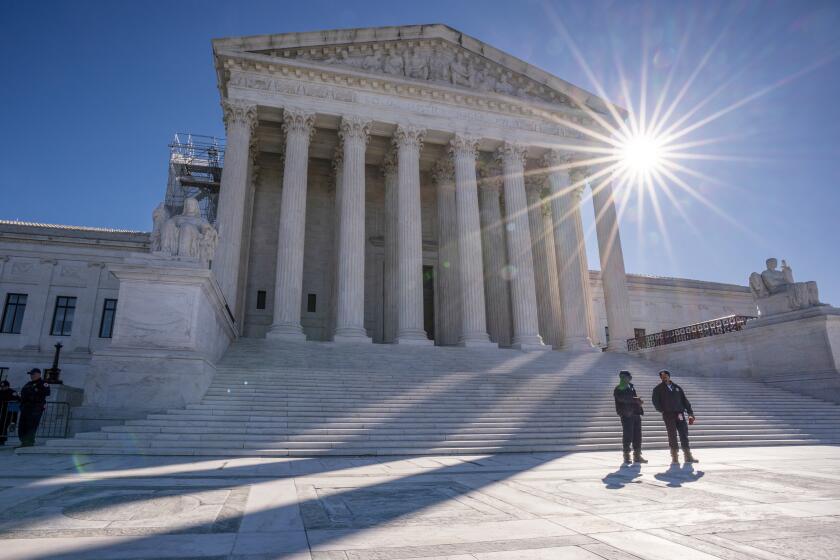FAA Orders Checks of 747 Fuel Pumps
- Share via
NEW YORK — The Federal Aviation Administration ordered airlines Wednesday to immediately inspect a pump in the center fuel tank of older Boeing 747 aircraft to reduce the chances of the kind of disastrous explosion that killed all 230 people aboard TWA Flight 800.
While stating that it knows of no evidence that the scavenge pump--which removes leftover fuel from the tank--caused the crash on July 17, 1996, the FAA said inspections revealed that the pump’s silicone insulating material could break down.
The result could be fuel leaking into the wheel well of the plane’s main landing gear, potentially causing a fire.
At the same time, the FAA issued notice of proposed rule-making that could result in a requirement that airlines insulate or separate certain wiring on 747s to lessen the chances of short circuits that might cause sparks in the center fuel tank.
The agency’s orders were its most comprehensive actions since the crash.
What precisely caused Flight 800 to plunge into the Atlantic Ocean minutes after taking off from New York’s John F. Kennedy International Airport is still unknown. But investigators believe that an electrical spark may have ignited a volatile mixture of air and remaining fuel in the center tank.
Because the plane carried a light load, the center tank was almost empty when the aircraft left for Paris.
“Although the National Transportation Safety Board has not yet determined the cause of the tragic accident, and we know of no evidence that these parts played any role in the accident, the FAA is ordering these changes to ensure that we take every practical step to ensure the continued safety of the Boeing 747,” said FAA Administrator Jane Garvey.
Last week, the FBI closed its massive investigation of the crash after finding no evidence that terrorists attacked the jumbo jet with a bomb or a missile.
More than 1 million pieces of the plane were pulled from the Atlantic, and 92 feet of the fuselage were reassembled in a hangar at Calverton, N.Y., in an effort to determine the cause of the accident.
But divers failed to find the center fuel tank’s scavenge pump.
The FAA said it was requiring immediate inspection of the wiring on the soda-can sized pump aboard 196 U.S.-registered older Boeing 747 planes to detect possible deterioration of insulating materials in the electrical connectors.
As part of its intensive scrutiny of Flight 800, officials of the NTSB removed a scavenge pump from an out-of-service 747 and studied the part.
Inspectors found that some of the pump’s electrical connectors use a silicone insulating material that is incompatible with the coolant and lubricant of the scavenge pump’s motor.
“This results in a gradual breakdown of the insulating material that could cause a fuel leak through the pump connector into the main landing gear well and cause a fire,” the FAA said in a statement.
The FAA required replacement within 90 days of scavenge pumps that are found to have silicone materials.
At the same time, the FAA issued what is called a Notice of Proposed Rule-Making, aimed at increasing protection against short circuits in the fuel-quantity indication system on 747s.
The agency said recent tests revealed higher-than-expected voltage spikes were possible when wiring from the fuel indication system was placed next to higher-voltage cables. When equipment was turned on and off, the spikes occurred through electromagnetic interference.
“The voltage was quite a bit higher than we expected,” said an FAA official.
Inspection of the center fuel tanks of some 747s after the TWA crash revealed metal contamination, including solder and safety wire in some of the tanks. This debris could lodge in the fuel-quantity indication system and cause a short circuit, the FAA said.
“If the contamination is present when the higher induced voltage is also present, a spark could be created in the fuel tank,” the agency said.
The FAA’s notice called for the installation of wire shielding and separation of fuel-indication wiring from other cables aboard the planes.
The notice proposed a 90-day comment period from interested parties and a 12-month compliance deadline to make the changes.
Boeing Co. spokesman Russ Young said Wednesday that the company already had issued a service bulletin for the scavenge pump’s connectors and that the FAA’s order for inspections “is a precaution that should be taken.”
However, Young said the company would be questioning how the government conducted tests on the fuel-quantity indication system.
“We believe all the conditions of the tests involve voltage levels much higher than found on the airplane,” he said. “This was a laboratory test to our understanding and would not be indicative of the airplane in service.”
The FAA said the scavenge-pump inspections and the wiring protections were precautionary, and that it might recommend other changes after the NTSB holds comprehensive hearings into the crash in Baltimore next month.
The NTSB has already indicated that further tests will be necessary to try to pinpoint precisely what caused Flight 800 to crash.
The FAA has taken a series of actions involving the fuel system of 747s since the Flight 800 accident.
In August 1996, it required inspections of all Boeing 747 and 757 fuel pumps. Last January, it required reinspection and repair of wiring leading to fuel tank booster pumps on 747s made before 1980. These safety requirements have been met, the agency said.
More to Read
Sign up for Essential California
The most important California stories and recommendations in your inbox every morning.
You may occasionally receive promotional content from the Los Angeles Times.










